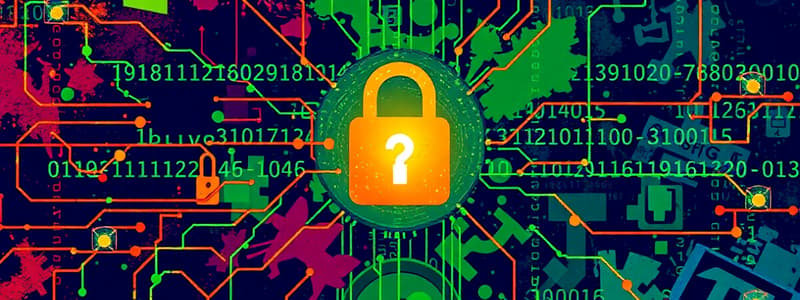Podcast
Questions and Answers
What is a primary goal of Data Loss Prevention (DLP)?
What is a primary goal of Data Loss Prevention (DLP)?
- To prevent unauthorized physical access to data centers
- To detect and prevent the transfer of sensitive information out of the organization (correct)
- To enhance data encryption for stored files
- To improve employee productivity with data usage
Which of the following is NOT a type of DLP system?
Which of the following is NOT a type of DLP system?
- Network-Based DLP
- Cloud-Based DLP
- Application-Based DLP (correct)
- Endpoint-Based DLP
What is the purpose of a structured walk-through?
What is the purpose of a structured walk-through?
- To perform a data analysis for system performance enhancement
- To train employees on policy changes via written procedures
- To evaluate compliance with data regulations through documentation
- To simulate real emergency situations such as disasters (correct)
Which step is the last in the walk-through process?
Which step is the last in the walk-through process?
Which safeguard for data at rest focuses on protecting the physical environment of data storage?
Which safeguard for data at rest focuses on protecting the physical environment of data storage?
What is the primary distinction between privacy and confidentiality?
What is the primary distinction between privacy and confidentiality?
Which of the following methods is an example of obfuscation?
Which of the following methods is an example of obfuscation?
What is a key disadvantage of symmetric encryption?
What is a key disadvantage of symmetric encryption?
Which of the following best describes hashing?
Which of the following best describes hashing?
Which statement accurately represents asymmetric encryption?
Which statement accurately represents asymmetric encryption?
Flashcards
Privacy
Privacy
Protecting individual rights and giving them control over their personal information.
Confidentiality
Confidentiality
Protecting information from unauthorized access and disclosure. It's about keeping data confidential.
Obfuscation
Obfuscation
Replacing sensitive data with less valuable data to protect it from unauthorized access.
Symmetric Encryption
Symmetric Encryption
Signup and view all the flashcards
Hashing
Hashing
Signup and view all the flashcards
Data Loss Prevention (DLP)
Data Loss Prevention (DLP)
Signup and view all the flashcards
How does DLP work?
How does DLP work?
Signup and view all the flashcards
Network-Based DLP
Network-Based DLP
Signup and view all the flashcards
Cloud-Based DLP
Cloud-Based DLP
Signup and view all the flashcards
Endpoint-Based DLP
Endpoint-Based DLP
Signup and view all the flashcards
Study Notes
Confidentiality and Privacy
- Privacy protects an individual's rights and gives them control over their information.
- Confidentiality protects information from unauthorized access.
- NIST defines confidentiality as preserving restrictions on accessing and disclosing data, including protecting personal and proprietary information.
Obfuscation
- Obfuscation replaces sensitive data with less valuable data for unauthorized users.
- Methods include encryption, tokenization, and masking.
Tokenization
- Tokenization replaces sensitive data with a surrogate value (token).
- Examples include random number generators, hashing, and encryption.
Masking
- Masking swaps data to disguise identifying information.
Encryption
- Encryption is the highest level of data protection.
- Data must be encrypted at rest and in transit.
Symmetric Encryption
- Symmetric Encryption uses a single private key for encryption and decryption by all involved parties.
- This method is commonly used by banks and in Virtual Private Networks (VPNs).
- Downsides: requires sharing a private key among all parties, is complex in large-scale scenarios, and does not guarantee non-repudiation.
Asymmetric Encryption
- Asymmetric Encryption uses a public key for encryption and a private key for decryption.
- More secure, but slower than symmetric encryption, requiring more computing resources.
Hashing
- Hashing creates a one-way transformation of a message into a fixed-length hash value (message digest).
Ciphers
- Ciphers use symbols or letters to replace actual data, e.g., substitution or transposition ciphers.
Data Loss Prevention (DLP)
- DLP aims to prevent unauthorized transfer of sensitive information.
- DLP methods include pattern matching and word recognition.
- Steps for a DLP program:
- Implement DLP program
- Define enterprise data
- Evaluate data types
- Monitor sensitive data use
- Enforce security policies
- Implement education
DLP System Types
- Network-Based DLP: prevents outgoing data transfers on networks.
- Cloud-Based DLP: prevents outgoing data transfers in cloud environments.
- Endpoint-Based DLP: scans files on endpoint devices (printers, USB drives, laptops).
Safeguards for Data at Rest
- Physical security protects data storage hardware.
- Digital security protects data digitally.
- Authorization/Access controls manage who can access data.
- Change management governs changes to systems and data.
- Backup and recovery ensures data restoration in case of loss.
Walk-Throughs
- Walk-throughs assess program logic, design, features, and functionality.
- Read-through: review of security, confidentiality, and privacy procedures.
- Structured walk-through: role-playing or simulating a disaster scenario.
- Fire drill: simulating an emergency.
- Walk-through steps: planning & preparation, understanding, performing walk-through, documentation, testing, evaluation & report.
Studying That Suits You
Use AI to generate personalized quizzes and flashcards to suit your learning preferences.




